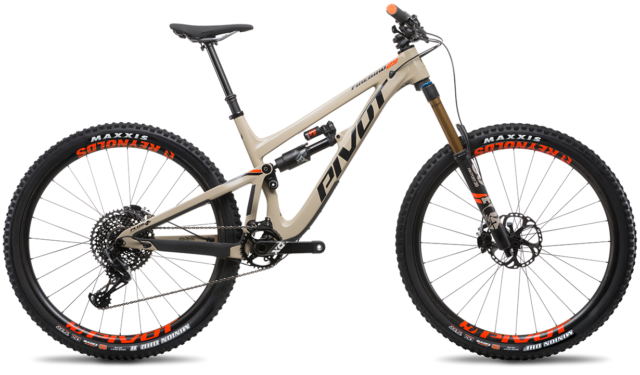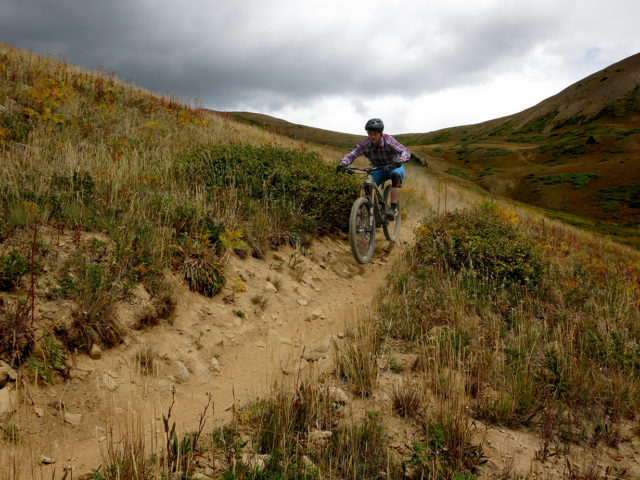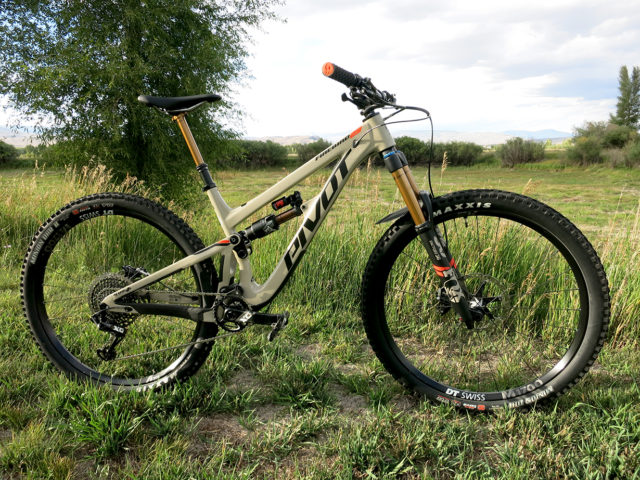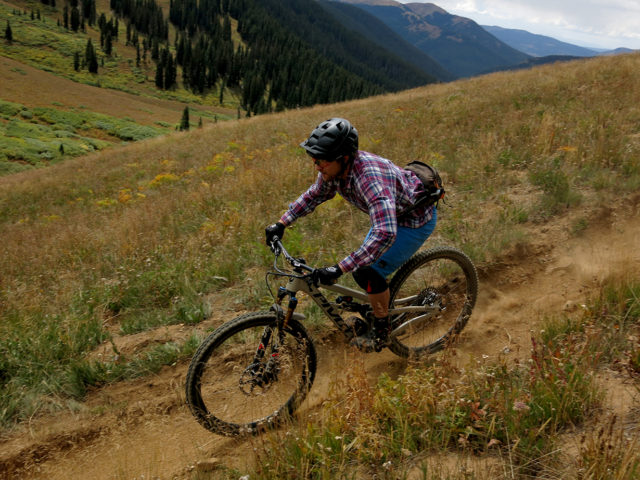2018 Pivot Firebird 29
Size Tested: Medium
Geometry: Here
Build Overview:
- Drivetrain: Sram X01 Eagle
- Brakes: Shimano XT Trail
- Fork: Fox Factory Grip2 36
- Rear Shock: Fox Factory Float X2
- Wheels: DT Swiss M1700
Wheels: 29″
Travel: 162 mm Rear / 170 mm Front
Blister’s Measured Weight: 30.5 lbs (~13.8 kg) without pedals
Reviewer: 5’10”; 165 lbs; Ape Index +1.5; Inseam 31″
Test Location: Gunnison & Crested Butte, Colorado
Duration of Test: 2 Months
MSRP: $7649

Intro
Purportedly, the staff at Pivot Cycles HQ has taken to referring to the Firebird 29 affectionately as “Big Bird” — much to the chagrin of Pivot Cycles founder, Chris Cocalis.
Since the first day I rode it, my own nickname for this bike has been #Firechicken, since I can’t find a better description of the character of this bike than that it descends like it’s on fire, and the only speed limit is the one you set for yourself. How chicken are you?
It is very clear that the details were important in the design and implementation of the Firebird 29, and it seems to me that the design of this bike was at least in part driven by attaining benchmarks. A 7 lb frame, 16.97” chainstays, 162 mm of rear travel… these are all aggressive goals that took time and energy to fit together into one package. The Firebird 29 was not part of the first generation of long-travel 29’ers to be released to market, and it’s apparent that Pivot has been paying attention to what is working well in the category, and have added their own take on the formula.
So what’s the result?
The Frame
The Firebird 29 is currently only available as a carbon frame, and is built around Dave Weagle’s dw-link suspension platform. The dw-link has been around for years and has gone through a number of updates and revisions over its lifespan, and the result is a suspension platform that does an admirable job of finding a balance of both pedaling efficiency and terrain-tracking, bump-absorbing, descending awesomeness. For more on suspension designs, check out our Suspension 101 article.
The Firebird 29’s huge carbon tubes immediately stand out, including a full 1.5” headtube (which makes it easy to further tweak the bike’s front end to your heart’s delight) and some massive bracing in the rear triangle makes it clear from the get-go that this thing is meant to be stiff. Which it is. But Pivot has also clearly spent a lot of time designing this frame to be light. Which it is.
Coming in at ~3.175 kg (7 lbs), the Firebird 29’s frame weight is very competitive. It does, however, lead me to a disconcerting aspect of the bike. Carbon walls on the bike’s top tube (specifically located in the area above the shock) have been so exactly engineered that you can actually flex the tube wall by hand. Over time, I’ve come to trust the Pivot engineers, and lack of frame stiffness has entered my mind exactly zero times while riding the Firebird 29. (But I sure wouldn’t mind if this frame weighed in at 7.1 lbs, if it meant that I didn’t need to feel the frame flex a bit.)

The Firebird 29 uses a 157 mm rear hub spacing in a configuration called “Super Boost Plus 157,” which Pivot introduced about two years ago with the well-received Switchblade. Basically, it means you get super short chainstays (for a 29’er), room for big tires, and a stiffer rear wheel.
Molded rubber guards provide good coverage and protection throughout the Firebird 29’s frame. Pivot utilizes internal cable routing and a clever cable tension / retention system at entry and exit ports for easy installation, a clean look, as well preventing noise from cable-slap inside the frame. Enduro Max bearings are used throughout pivot locations to ensure long life and no play. Small details like this really come together coherently throughout the Firebird 29.
There are a couple dings against an exceptional frame. First, even though it’s so cliché it hurts, the frame cannot accommodate a water bottle inside the front triangle (but does do so underneath the downtube). Second, because of the clevis design that Pivot utilizes with the Firebird 29’s suspension layout, and the increased leverage it places on the shock shaft and piston bushings, coil shocks are not recommended for this frame (however, the air options are in no way lacking). Third and finally, unlike many previous Pivot bikes, the Firebird 29 is not Di2 compatible. It has a Di2 battery port and Pivot’s Cable Port System for simple routing but the frame does not feature the Di2 wiring holes between the front triangle and swingarm. (But who will use Di2 on this bike anyway, now that Shimano is releasing their 12sp group?)
The Build
Again, Pivot showcases attention to detail that leaves little to upgrade or change (except for brand loyalty or personal preference) on their builds. The Firebird 29’s Pro X01 build that I tested does everything I could want it to. Bars are wide, stem is short, plenty of gears, and a 32th chainring is present so you’re seldom spun out. Shimano XT 4-piston brakes offer great power and awesome lever feel, though I’d highly recommend swapping out the brake pads before riding, since the factory pads rattle in the calipers frequently.
The DT Swiss M1700 wheels and 2.5 DHF and 2.4 DHR2 EXO tires from Maxxis featured here are something that I would spec if I were building a bike from the ground up.
I upgraded my bike to the Fox Factory Float X2 (a $125 upgrade over the Performance Float X2 that comes stock on the Pro X01 build) for the single reason that my borderline OCD personality would not allow me to ride a bike with both Kashima, and non-Kashima suspension. There, I said it. YMMV.

The suspension itself is a standout feature of the build. The 170mm-travel Fox 36 FIT Grip2 Factory fork is extremely supple off the top, and the Grip2 damper provides all the adjustment I could want. Traction abounds on the front end, and neither high-speed chatter nor big compressions caused any discernible deflection of the fork.
Amid such a tight package, something that stands out is the slight fluid squishing noise the fork makes as it cycles during rebound, but other than the noise, it has no impact. The Float X2 similarly has the high- and low-speed adjustments necessary to dial the rear end of the bike into the ride characteristics you are looking for, and it performed exceptionally throughout my testing. The climb lever is a nice addition that provides some additional compression damping to help the bike stand up more in its travel when things point uphill.
The Firebird 29’s cockpit is excellent and made up of Pivot components. The bars are stiff without being punishing, the stem is low profile and otherwise inconspicuous, and the grips utilize some well-thought-out tech to aid in rider comfort. The grips integrate WTB’s PadLoc grip system and provide great damping on my hands and keep the grips from twisting. That said, the padded wedge interface on the outside of the grip is a bit flexy when gripping the bar, the proprietary design does limit grip selection, and the notch in the bar makes cutting them down a bit more tedious. It all works really well in implementation, but is an example of where proprietary design makes it a bit harder to change individual components to suit personal preference if needed.
Fit and Geometry
Complete geometry for the Firebird 29 can be found here. Pivot has continued the trend that started with the Firebird 27.5, and made a point to stretch out the Firebird 29 as compared to many of their other models. I rode a Medium frame, and while the 454.7 mm reach number was one of the largest I have spent time under, the fit felt natural with the short stem, reduced fork offset, and acceptably steep seat tube angle. With the 45 mm stem and bars cut down to 780 mm, my position on the bike was extremely neutral with weight balanced roughly 50/50 between front and rear. Most importantly, I didn’t find myself needing to use my elbows to regulate my distance over the front end of the bike. A natural bend was all it took to consistently be in the right spot.
With a low standover height and short seat tube length of 424 mm, the 150 mm dropper which is spec’d could have easily been a 170mm. It would be great if Pivot offered this as a factory option to better fit riders who could benefit. Especially when Pivot includes their trick saddle collaboration with WTB, the Hightail Trail, which has a cutout in the back of the saddle to better accommodated lowered seatposts and compressing suspension without rubbing between tire and saddle.

The Firebird 29 also has the ability to run some big rubber. Up to a 2.6″ wide 29er tire, or a 2.8″ tire on a 27.5″+ wheel. This is accommodated through an easy to use flip-chip system, as well as an interchangeable bottom headset cup. I have not spent much time on plus-sized tire systems, and I don’t see that changing with the Firebird 29. This bike is already a damp ride with tons of traction, and I would be hesitant to add wider tires that would likely result in increased vagueness at speed. This bike wants to go fast and be a berm slapper, and in my opinion, plus-sized rubber would decrease rider confidence.
Also worth noting with respect to fit: I experienced good heel clearance, with no rubbing on the rear triangle while pedaling throughout my time with the Firebird 29.
Finally, at this time, I have not experimented with the bike in its “high” geo mode, and feel little need to do so. The Firebird 29 already has a comparatively high-ish bottom bracket height, and while it’s not something that I currently notice while riding thanks to a q-factor that gives me a nice tripod of support when standing on the cranks and dynamic sag that brings me closer to the ground, I also don’t have any desire to raise it farther. I found The 65° head angle is right where it needs to be for a bike this capable when pointed downhill.
The Ride
Climbing
With so much suspension on tap both front and rear, the Firebird 29 is not a bike that rewards the rider who attacks out of the saddle regularly. When sitting and spinning, the dw-link suspension does an excellent job of keeping things efficient, suspension movement to a minimum beyond reacting to trail noise, and your energy pushing the bike forward. I did not find any need for the Float X2’s climb lever on short attacks on the trail, but after years of various suspension and shock platforms, I am pre-programmed to use it, and did so often. I was using the climb lever any time I was going to be spinning uphill for a while, and it was definitely an efficiency / energy saver on high-energy-output or long climbing situations. Traction was excellent with or without the climb lever, thanks to a suspension platform that conforms to terrain well, the sensitivity of the Float X2, and the Maxxis DHR II on the rear of the bike.

The one area where things didn’t shine quite so brightly while climbing was when the trail turned truly steep. I found myself working a bit harder to stay over the front of the bike, and felt as though I was dipping further into the suspension’s travel than I would have liked in these instances. The seat tube angle on the Firebird 29 is squarely average in today’s bike geo numbers, and I think had the STA been slightly steeper, it may have helped. A good cadence was more important during these efforts, and while no deal breaker, when it got really steep the bike did require a bit more energy and input from me at a time when I was least interested in offering it up.
Descending
The Firebird 29 is very, very fast when pointed down a hill with any gradient, and I have set new PR’s on every section of trail I have ridden aboard the Firebird 29. The overall package of a stiff frame with long and slack geo numbers, excellent suspension, and aggressive rubber all provide for higher cornering speeds, later braking, and higher average mph’s. The 2.5” DHF and 2.4” DHR II fit the character of this bike perfectly, and I’d put another set on when the first wears out. Both cornering and braking traction is immense and the combination of a big contact patch and meaty tires meant that it became a game to see how late I could brake before hitting corners.
Overall, the way I chose to set up the suspension meant that the bike rode quite mute and really worked to smooth out the trail. But I liked it and wanted it this way — I was looking for grip. For the rider who wants a more active or lively ride, you can get that by fiddling with the damper adjustments, and the bike would become more dynamic and active on the trail. But at the end of the day, this is a bike with big wheels and a lot of travel, so it’s never going to feel like a whippy slopestyle bike.

It’s important to talk a bit more about what an excellent job this bike does of smoothing out trail and creating grip. As mentioned, a big component of this is the suspension and tires, but there are some other factors in play as well. The Fox 36 spec’ed on the Pro X01 Firebird 29 uses Fox’s new 44mm offset, and does noticeably help to put me in a position to attack trail from a centered position on the bike, rather than needing to get weight over the front end so aggressively to control grip on the front tire. The wheels are also part of the equation, and from time to time I can feel some lateral flex. But as someone who’s 165 lbs and doesn’t frequently ride machine-built trails (and therefore doesn’t end up hitting corners / berms really hard), I never found it to be an issue. It helped to keep the tires where I wanted them on the trail, and I noticed no frame contact during the test.
The bike does thrive on trails that trend toward the steeper end of the spectrum, and it tends to mellow out rolling terrain for the same reasons mentioned above. It is also worth noting that the long wheelbase + slack head tube angle + big wheels mean it can be easier than you may be used to for the bike to stand you up a bit in tight, low-speed corners. So be ready to get that foot out there and let ‘er drift a bit!
Durability and Maintenance
Two months in and everything is still running smoothly. It is worth noting that Pivot’s website has excellent information and resources for buyers. Their FAQ pages make it super easy to answer bike / tech related questions quickly, and without going on a deep dive into the internet for answers.
With the relatively new Super Boost Plus 157 standard, you will need to exercise a bit of attention to detail when it comes to replacing or changing parts in the near future. Support exists already, you just have to pay attention to the spec details on cranks, chainrings, hubs, etc. With more manufacturers utilizing 157 spacing on bikes in 2018 and 2019, this should become less and less of an issue in the future.
Bottom Line
The Pivot Firebird 29 is dialed. The factory build needs nothing to get you started, and it can get you through most anything if you have the fitness. This is also a good bike to race on.
If you want to be (and you work to be) faster each time you ride your bike, the Firebird 29 could be a good fit. It is a big bike with big wheels and a lot of suspension travel, but it still has the pedaling efficiency to continue to reward you as you build fitness throughout the season. And more importantly, as you learn the limits of the bike’s grip and character, you will find yourself being continually rewarded with faster times on the descents. If you ride fast terrain, big terrain, or rough terrain, the Firebird 29 is a tool that will push you further.
If you are someone who tends to be a bit more passive on a bike ride — rather than viewing rides as a chance to go into attack mode — there are likely bikes out there that would be a better fit. As I said at the top, the Firebird 29 wants to be ridden like it’s on fire, and it rewards riders who approach it with a corresponding level of urgency and energy.

Thanks for the good test, Eric. I do the same with the climb switch you do.
Now I think you are perfectly suited to test the Yeti SB150.
Have fun!
Thanks Lukas. I hope I have the opportunity to try the SB150. It looks pretty sweet!
With longer chainstays, it would climb and descend better, at the expense of some playfullness. But since it doesn’t sound like a playfull bike to start, nothing lost.
Hey Joe. Hard to say without having some different chainstay lengths to play around with on this specific bike. I can say this… throughout the test, I never found myself thinking about CS length much. Meaning only, for this bike, I think they found geo/#’s that work really well. Bike climbs well for what it is, and is exceptionally fast pointed downhill.
Re chainstay length:
remember, this is only a medium, so the front center is fairly short anyway. Then there is the shorter offset fork. This has about the same effect on (standing)weight distribution as ~15mm longer chainstays would have with a standard 51mm offset.
What hip pack is the rider wearing?
Hey Andre- it’s a Dakine Hot Laps 5L Lumbar Pack!